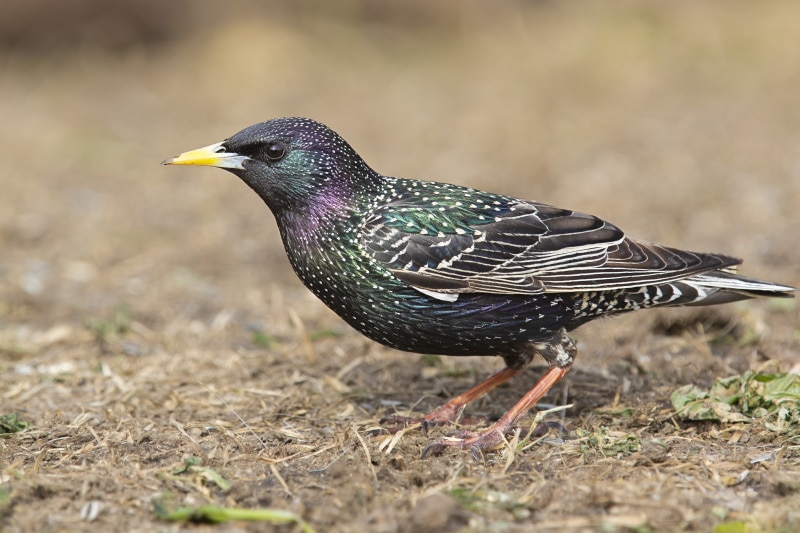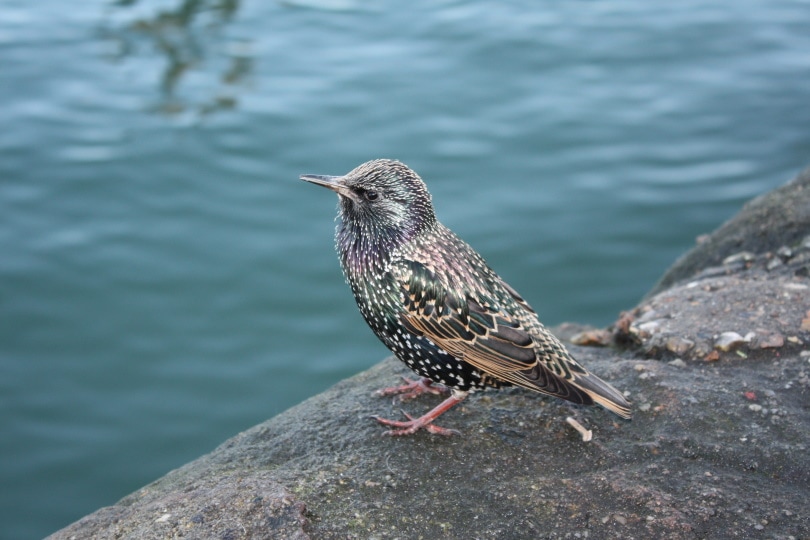How Did the European Starling Get to America? The Fascinating Answer!
Last Updated on

With a peak population of 200 million breeding adults spread across North America, most people have probably come across the iridescent non-native songbirds known as European starlings at some point or another.
While some might adore the intelligent birds and see their murmurations as awe-inspiring wonders, there is no doubt that others see them as harmful pests—and it’s not without reason. The U.S. Department of Agriculture estimates that starlings cause $800 million in agricultural damage1 every year.
For decades, there has been a widespread belief that all present-day starlings in North America are descendants of 100 starlings released in 1890 into Central Park in New York by Eugene Schieffelin. The claim is that Schieffelin was a Shakespeare fanatic who embarked on a mission to introduce all the birds mentioned in the bard’s works to America.
Shakespeare once wrote, “Truth will come to light…. At length, truth will out,” and though it did take a while, in 2021, researchers proved2 that starlings were introduced to North America long before the attempt at Central Park.
In this article, we’ll discuss the fascinating history of how the European starling came to America.

The Acclimatization Movement
In the 19th century, acclimatization societies worldwide introduced different species of animals and plants to foreign environments. The main motivation was that these groups believed these introductions would enrich the flora and fauna of the host regions. On the other hand, some of it was experimental.
By observing how well a species—for example, the European starling—survived or thrived in a location, the observers would learn more about its physiology. While it is now a well-known fact that introducing non-native species to an environment can cause irreparable damage, in the 1800s, the endeavor was largely perceived positively.
Between 1872 and 1874, the Acclimation Society of Cincinnati released around 4,000 European birds, including starlings, into the wild. Similar introductions followed in Quebec, and New York.
The American Acclimatization Society explained that the program would bring “birds which were useful to the farmer and contributed to the beauty of the groves and fields.”
During his investigation, Edward Howe Forbush heard an account from Massachusetts that “four starlings were caught from a small flock on the estate of Mr. Stephen Salisbury on November 8, 1876,” suggesting that wild flocks of starlings had already been established long before the Central Park introduction in 1890.

1890 – Eugene Schieffelin
The story of Eugene Schieffelin, the socialite who released a flock of starlings into Central Park in 1890 is not all fiction. Schieffelin was chair of the American Acclimatization Society, and he really did release a flock of 100 starlings in Central Park, New York. However, there is nothing to suggest he cared for Shakespeare.
Eugene Schieffelin’s attempt to introduce starlings to America would have been one of the last, because a few years later, the Lacey Act of 1900 prohibited the introduction of non-native species to the United States.
Why is the European Starling a Problem?
European starlings can cause hundreds of millions of dollars worth of damage to crops. Although these birds will first seek to eat insects, once this food source becomes scarce, they will turn to grains and fruit.
The other problem with all invasive species, including starlings, is that they outcompete native songbirds and cavity nesters. For example, starlings will sometimes expel bluebird eggs from nests and bird boxes. Starlings sometimes show aggressive behavior towards other birds by attacking them, fighting over food, and scaring them away from their nesting spots.

Can You Keep a European Starling as a Pet?
You wouldn’t be able to purchase a starling, but some people who find abandoned or orphaned starlings do adopt them.
As pets, starlings become attached to their carer. They are intelligent birds that can be housetrained and taught tricks. Starlings are excellent mimics, and will learn to talk over time as they mimic their owner.
What Can I Feed a European Starling?
Starlings are generalist eaters, so their diet is varied. They do have a preference for insects and small invertebrates including beetles, grasshoppers, spiders, worms, and flies. When insects are not easily available, starlings will happily eat seeds, nuts, and berries.

How Long Can a Starling Live In Captivity?
Most pet starlings are found as chicks, after falling out of their nests or being abandoned. These starlings cannot adapt back to life in the wild, and must be kept in captivity their entire lives. If cared for properly, starlings in captivity can live up to 20 years or longer.
Final Thoughts
European starlings were introduced to the United States by various acclimatization organizations and individuals during the 19th century. At the time, it was seen as a positive thing to do, to enrich the local flora and fauna. Eugene Scheffler really did release 100 starlings into Central Park in New York, but he was one of the last to do so.
Connections between Scheffler, Shakespeare, and starlings were made decades after Scheffler’s death. But the anecdote of the Shakespeare fanatic, who’s to blame for today’s 200 million starling population, has since become popular folklore nonetheless.
Featured Image Credit: Pxhere
About the Author Cheryl Regan
Cheryl is a freelance content and copywriter from the United Kingdom. Her interests include hiking and amateur astronomy but focuses her writing on gardening and photography. If she isn't writing she can be found curled up with a coffee and her pet cat.
Related Articles:
Can You Use Binoculars to Look At Stars? How to Choose the Right Pair
10 Types of Hummingbirds in Arkansas (With Pictures)
8 Types of Hummingbirds in Nebraska (With Pictures)
5 Types of Hummingbirds in Idaho (With Pictures)
3 Types of Hummingbirds in Mississippi (With Pictures)
8 Types of Hummingbirds in Kansas (With Pictures)
5 Types of Hummingbirds in West Virginia (With Pictures)
5 Types of Hummingbirds in Ohio (With Pictures)
